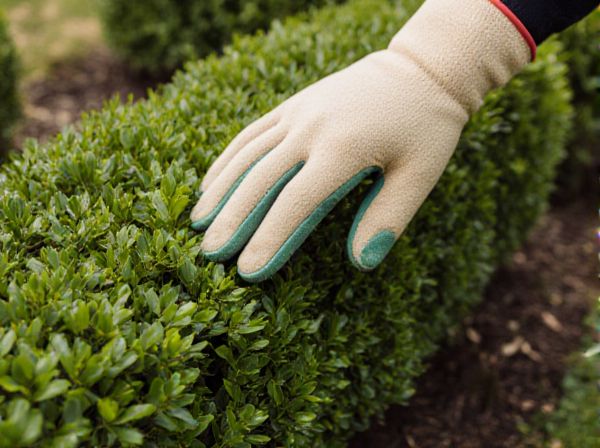
boxwood parterre vs perennial border Illustration
A boxwood parterre offers a formal, structured appearance with neatly trimmed evergreen hedges creating geometric patterns, ideal for classic garden designs. In contrast, a perennial border provides a more relaxed and colorful display, combining a variety of flowering plants that change throughout the seasons. Choosing between these options depends on whether you prefer a tidy, sculpted look or a vibrant, natural abundance in your ornamental garden.
Table of Comparison
| Feature | Boxwood Parterre | Perennial Border |
|---|---|---|
| Structure | Formal, geometric shapes using dense boxwood shrubs | Informal, mixed planting of various perennials |
| Maintenance | High; requires regular pruning and shaping | Moderate; seasonal care and deadheading needed |
| Seasonal Interest | Year-round evergreen foliage | Seasonal blooms with varying colors and textures |
| Plant Variety | Primarily Buxus species | Diverse perennial species |
| Design Style | Classic, formal garden aesthetic | Naturalistic, cottage garden vibe |
| Best Use | Structured garden focal points and pathways | Colorful garden edges and wildlife habitats |
Understanding Boxwood Parterre: Structure and Design
Boxwood parterres showcase intricate geometric patterns formed by low hedges of Buxus sempervirens, defining elegant garden rooms with symmetrical, formal layouts. Their evergreen foliage provides year-round structure and contrast against seasonal plantings, creating a striking visual framework that enhances the ornamental appeal. Unlike perennial borders, boxwood parterres emphasize precise shape and repetition, offering a timeless design element essential to classic and contemporary garden architecture.
What Defines a Perennial Border Garden?
A perennial border garden is defined by its structured arrangement of long-lived flowering plants that provide seasonal color and texture, often designed in layered heights to create visual depth. Unlike a boxwood parterre, which emphasizes formal, geometric shapes and evergreen foliage, perennial borders highlight diversity and naturalistic planting schemes with blooms that recur annually. This type of garden prioritizes plant variety, bloom succession, and a balanced mix of foliage to ensure continuous interest throughout the growing season.
Historical Origins: Boxwood Parterre vs Perennial Border
Boxwood parterres originated in 16th-century French Renaissance gardens, characterized by intricate, geometric patterns formed with low, clipped boxwood hedges that created symmetrical, formal designs. Perennial borders gained popularity in English gardens during the 18th and 19th centuries, featuring mixed plantings of flowering perennials that emphasized naturalistic, informal aesthetics. The historical contrast highlights the boxwood parterre's roots in formal, controlled garden design versus the perennial border's evolution toward seasonal color and ecological diversity.
Aesthetic Appeal: Formality vs Natural Flow
Boxwood parterres offer a highly formal aesthetic appeal with their structured, geometric shapes and neatly trimmed evergreen foliage, creating a sense of order and elegance. In contrast, perennial borders provide a natural flow through varied plant heights, colors, and textures, fostering a relaxed, organic atmosphere that evolves with seasonal blooms. Choosing between a boxwood parterre and a perennial border depends on whether the desired garden style emphasizes classical symmetry or a more informal, dynamic landscape design.
Plant Selection: Evergreens versus Flowering Perennials
Boxwood parterres showcase structured elegance using evergreen shrubs like Buxus sempervirens, providing year-round greenery and formal shapes that enhance garden architecture. Perennial borders emphasize seasonal vitality with diverse flowering perennials such as Echinacea, Rudbeckia, and Salvia, offering vibrant colors and varying textures through bloom cycles. Selecting evergreens like boxwood ensures consistent foliage, while flowering perennials contribute dynamic visual interest and ecological benefits across seasons.
Maintenance Requirements: Pruning and Upkeep
Boxwood parterres require regular shaping and pruning to maintain their formal, geometric designs, often demanding professional expertise and consistent care to prevent overgrowth and maintain crisp edges. Perennial borders need seasonal deadheading and occasional pruning to encourage healthy growth and extend blooming periods, generally involving less intensive upkeep compared to boxwood hedges. Both planting styles benefit from routine monitoring for pests and disease, but boxwood is particularly susceptible to boxwood blight, requiring vigilant maintenance practices.
Seasonal Interest and Year-Round Beauty
Boxwood parterres provide structured evergreen foliage that ensures consistent year-round beauty, maintaining visual interest even in winter months. Perennial borders offer dynamic seasonal interest through varied flowering times, foliage colors, and textures that change throughout spring, summer, and fall. Combining both enhances garden design by balancing the timeless formality of boxwood with the vibrant, evolving palette of perennials.
Wildlife and Biodiversity Considerations
Boxwood parterres create dense, evergreen structures offering year-round shelter but limited floral diversity, supporting primarily small birds and insects adapted to closed habitats. Perennial borders enhance biodiversity by providing a variety of flowering plants that attract pollinators, butterflies, and beneficial insects throughout the seasons. Integrating both elements maximizes wildlife habitats while maintaining ornamental appeal and ecological balance in gardens.
Space and Site Suitability for Each Style
Boxwood parterres require well-drained, sunny locations with ample space for intricate geometric patterns, making them ideal for formal gardens with limited room for vertical growth. Perennial borders thrive in diverse sites, including partial shade and varied soil conditions, allowing for taller, more dynamic planting schemes that suit larger, more informal spaces. Selecting the appropriate style depends on garden size and environmental factors, optimizing both visual impact and plant health.
Choosing the Right Style for Your Garden Vision
Boxwood parterres offer structured elegance with meticulously clipped hedges, ideal for formal garden designs emphasizing symmetry and order. Perennial borders provide vibrant, dynamic displays through varied plant heights and seasonal color changes, perfect for a naturalistic, informal aesthetic. Selecting between these styles hinges on your garden vision, balancing the desire for geometric precision against a more relaxed, colorful planting scheme.
boxwood parterre vs perennial border Infographic

 gardendif.com
gardendif.com